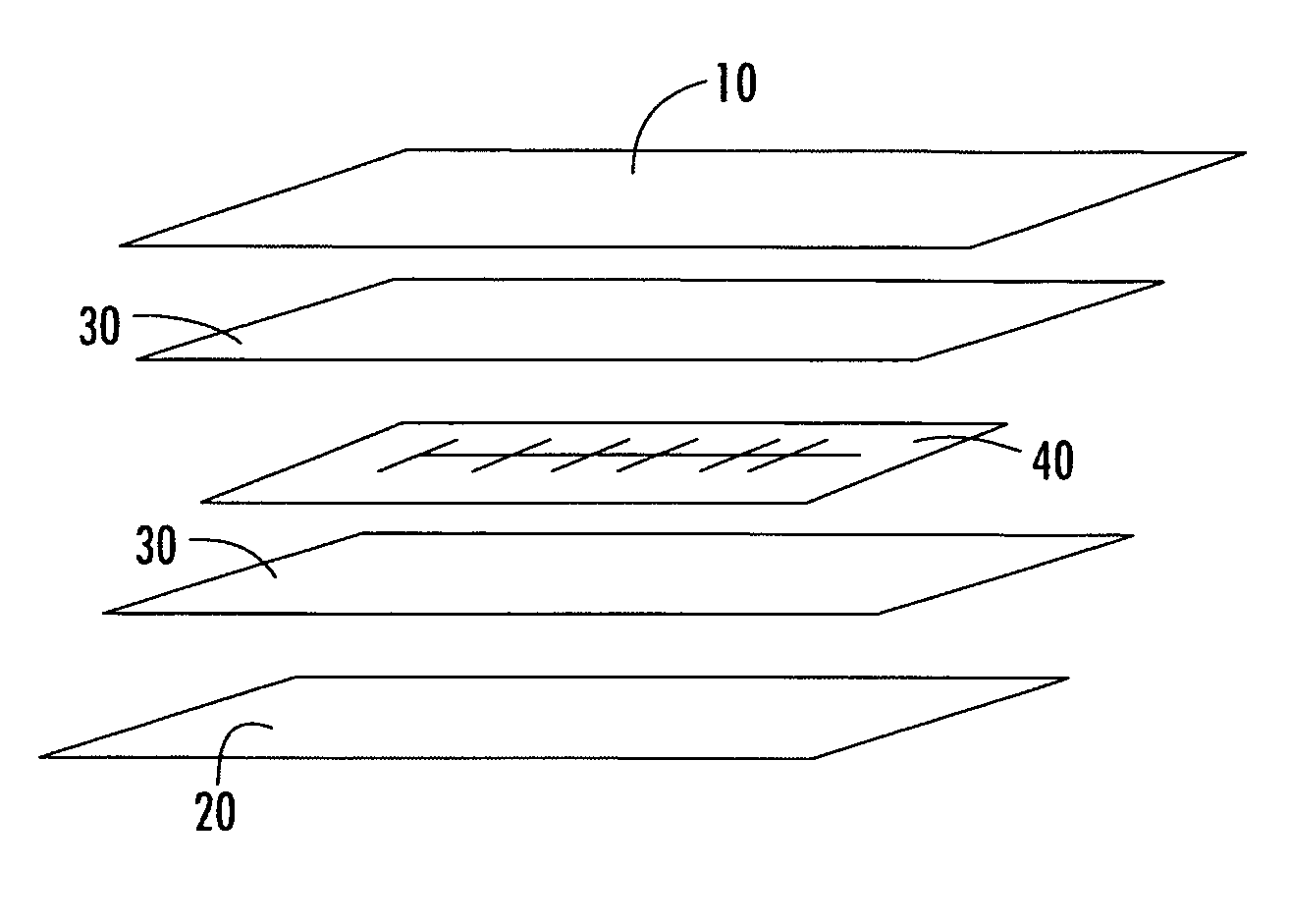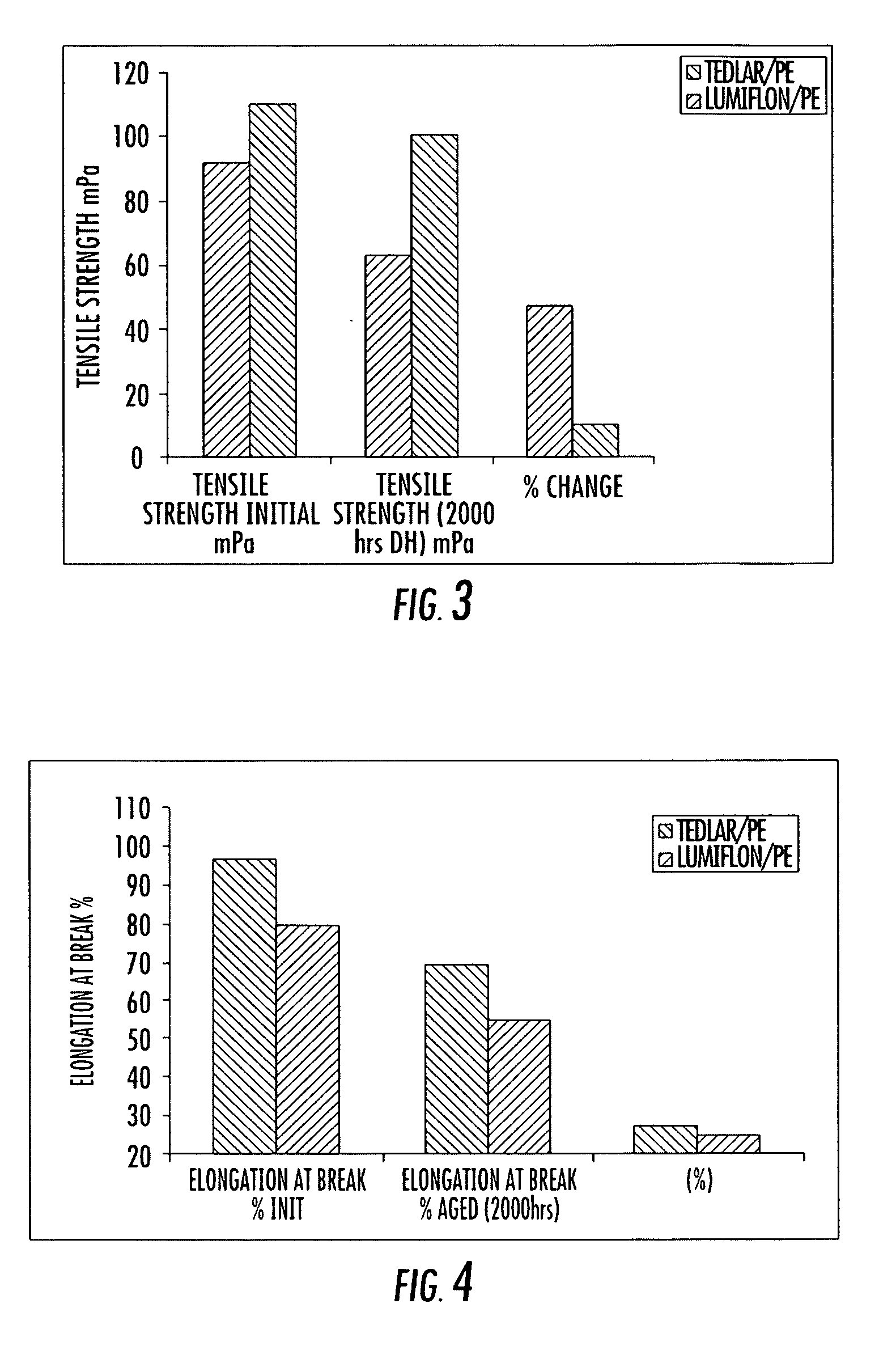Backing sheet for photovoltaic modules and method for repairing same
a photovoltaic module and backing sheet technology, applied in the direction of chemical instruments and processes, synthetic resin layered products, coatings, etc., can solve the problems of photovoltaic module production and installation remains an expensive process, photovoltaic elements, rusting in underlying parts, etc., to minimize the deterioration of solar module performance, good photoelectric conversion efficiency over a long period of time, and excellent weather resistan
- Summary
- Abstract
- Description
- Claims
- Application Information
AI Technical Summary
Benefits of technology
Problems solved by technology
Method used
Image
Examples
example 1
[0045]Example 1 illustrates the preparation of a Lumiflon®-based protective backing sheet according to the present invention. Lumiflon® used in this example is LF 200 grade, obtained from Asahi Glass as a 60% solution in xylene (200 g). Pigment used in this example is Ti-Pure® R-105, obtained from DuPont (76.2 g). The crosslinker is Desmodur® N3300, obtained from Bayer (21.4 g). The pigment is mixed with Lumiflon® solution using high shear mixer, followed by solvent and the crosslinker addition.
[0046]The formulation is then applied. The liquid formulation is transferred from the pan to the film by applicator roll and metered off by Mayer Rod to obtain the desired coating weight. The coating is applied directly on a Mylar® (DuPont) (5-mil) polyester film. No adhesive is required and in this example none is used. The coating is applied at a coating weight of 10-120 g / m2, preferably 30-90 g / m2, and more preferably 30-45 g / m2.
[0047]The dry coating consists of 60-65% by weight of Lumiflo...
example 2
[0055]Example 2 illustrates the preparation of an alternate embodiment of a Lumiflon®-based protective backing sheet according to the present invention. Lumiflon® used in Example 2 is LF 200 grade, obtained from Asahi Glass as a 60% solution in xylene (150 g). Pigment used in this example is Ti-Pure® R-105, obtained from DuPont (57 g). Hydrophobically modified silica used in this example is Cab-o-sil TS-720 (10 g) obtained from Cabot. The crosslinker used is Desmodur® N3300, obtained from Bayer (16 g). The catalyst used in this example is dibutyl tin dilaureate (0.15 g of 0.1% solution in MEK) obtained from Aldrich. The pigment and silica are mixed with Lumiflon® solution using high shear mixer, followed by solvent, crosslinker and catalyst addition.
[0056]The formulation is then applied. The liquid formulation is transferred from the pan to the film by applicator roll and metered off by Mayer Rod to obtain the desired coating weight. The coating is applied directly on a Mylar® (DuPo...
example 3
[0058]Example 3 illustrates the preparation of another embodiment of the present invention; a Lumiflon®-based “patch kit” formulation.
[0059]The Lumiflon based patch kit formulation is preferably prepared from a formulation comprising 2 separate components: A and B.
[0060]Component A comprises of a mixture of a crosslinker (Isocyanate Desmodur N3300 (2.5 g, Bayer)) and a solvent (in this Example, xylene).
[0061]Component B is comprised of a mixture of a solvent, pigment and a fluorocopolymer. In this Example Component B is prepared as follows. A dispersing agent (Disperbyk 111 (0.25 g, BYK-Chemie)) is mixed with xylene, 14.1 g of Lumiflon® LF 200, pigment Ti-Pure® R101 (10 g, DuPont), Orgasol® 2002D (4.7 g, Arkema Inc) and a mixture of coloring agents (Microlith Blue, Microlith Yellow, Microlith Brown and Orasol Black). Different coloring agents can be added to match the color of the torn backing sheet.
[0062]In use, components A and B are placed into a twin-chamber syringe equipped wit...
PUM
| Property | Measurement | Unit |
|---|---|---|
| Thickness | aaaaa | aaaaa |
| Temperature | aaaaa | aaaaa |
| Solubility (mass) | aaaaa | aaaaa |
Abstract
Description
Claims
Application Information
 Login to View More
Login to View More - R&D
- Intellectual Property
- Life Sciences
- Materials
- Tech Scout
- Unparalleled Data Quality
- Higher Quality Content
- 60% Fewer Hallucinations
Browse by: Latest US Patents, China's latest patents, Technical Efficacy Thesaurus, Application Domain, Technology Topic, Popular Technical Reports.
© 2025 PatSnap. All rights reserved.Legal|Privacy policy|Modern Slavery Act Transparency Statement|Sitemap|About US| Contact US: help@patsnap.com



